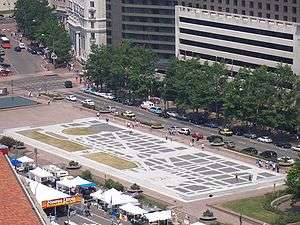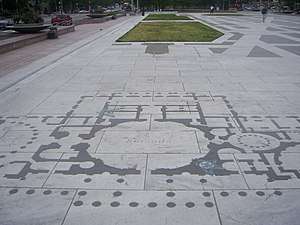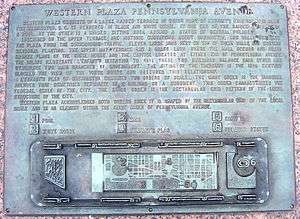Freedom Plaza
Freedom Plaza, originally known as Western Plaza, is an open plaza in Northwest Washington, D.C., United States, located at the corner of 14th Street and Pennsylvania Avenue NW, adjacent to Pershing Park. The John A. Wilson Building, the seat of the District of Columbia government, faces the plaza, as does the historic National Theatre, which has been visited by every U.S. President since it opened in 1835.[1][2] Three large hotels are to the north and west. The National Park Service administers the Plaza as part of its Pennsylvania Avenue National Historic Site and coordinates the Plaza's activities.[3]



Features

The Plaza is a modification of an original design by architect Robert Venturi that the United States Commission of Fine Arts approved.[1][2][4][5][6] The Plaza, which is composed mostly of stone, is inlaid with a partial depiction of Pierre (Peter) Charles L'Enfant's plan for the City of Washington.[4] Most of the plaza is raised above street level.[4] The eastern end of the plaza contains an equestrian statue of Kazimierz Pułaski that had been installed at its site in 1910 (see: General Casimer Pulaski statue).[4]
The surface of the raised portion of the Plaza, consisting of dark and light marble, delineates L’Enfant’s plan.[4] Brass outlines mark the sites of the White House and the Capitol.[4] Quotes about the city from its visitors and residents are carved into the marble surface.[4] Granite retaining walls, marked at intervals by planted urns, edge the plaza.[4] A granite-walled fountain flows in the western portion of the plaza.[4]
Flagpoles flying flags of the District of Columbia and the United States rise from the plaza opposite the entrance of the District Building.[4] The Plaza also contains a metallic plaque containing the Great Seal of the United States,[7] followed by an inscription describing the history and usage of the seal (See: Freedom Plaza Plaque).
The plaza is one block south of the "Freedom Plaza" historical marker at stop number W.7 of the Civil War to Civil Rights Downtown Heritage Trail at 13th and E Streets, NW.[1][2]
History
"Western Plaza" was constructed by the Pennsylvania Avenue Development Corporation and was dedicated on November 1, 1980 (see: History of Pennsylvania Avenue).[4] The plaza was renamed in 1988 to "Freedom Plaza" in honor of Martin Luther King, Jr., who worked on his "I Have a Dream" speech in the nearby Willard Hotel.[1][4][5] During that year, a time capsule containing a Bible, a robe, and other King relics was planted at the site.[4][8] The capsule will be reopened in 2088.[8]
Uses
Freedom Plaza is a popular place for political protests and civic events.[9][10] In 2011, the Plaza was one of the sites of an "Occupy DC" protest.[11]
The Plaza is also a popular location for skateboarding, although this activity is illegal and has resulted in police actions.[12][13][14] Skateboarding has damaged sculpture, stonework, walls, benches, steps and other surfaces in some areas of the Plaza.[13][14] Skateboarding presents a persistent law enforcement and management challenge, as popular websites advertise the Plaza's attractiveness for the activity.[14] Further, vandals have removed "No Skateboarding" signs.[14]
The Plaza is one of the settings in Dan Brown's 2009 novel The Lost Symbol.[15]
Assessment
The American Planning Association noted in 2014 that Freedom Plaza is a popular location for political protests and other events.[9] However, a reporter for the Washington Business Journal stated "but that does not mean the concrete expanse across from the John A. Wilson Building was well planned".[9] Many observers consider the site a "failure."[13]
References
| Wikimedia Commons has media related to Freedom Plaza. |
- Miller, Richard E. (2009-04-14). "Freedom Plaza: Civil War to Civil Rights: Downtown Heritage Trail marker". Historical Marker Database. Retrieved 2011-03-21.
- Busch, Richard T.; Smith, Kathryn Schneider. "W.7: Freedom Plaza: 13th and E Sts NW". Civil War to Civil Rights Downtown Heritage Trail. Washington, DC: Cultural Tourism DC. Archived from the original on 2016-03-21. Retrieved 2017-03-27.
- "What does this park contain?". Frequently Asked Questions: Pennsylvania Avenue National Historic Site: District of Columbia. National Park Service: United States Department of the Interior. Archived from the original on 2017-02-06. Retrieved 2017-03-27.
- "Pennsylvania Avenue National Historic Site" (PDF). National Register of Historic Places Registration Form: National Park Service: United States Department of the Interior. Washington, D.C.: Government of the District of Columbia Planning Office. pp. 191–192. Archived from the original (PDF) on 2017-01-07. Retrieved 2017-03-29.
- Cooper, Rachel (2017). "Freedom Plaza in Washington, DC". About.com: About Travel: Washington, DC: Sports & Recreation: Parks and Recreation: DC Parks. About, Inc. Archived from the original on 2017-01-26. Retrieved 2017-03-27.
- Miller, Richard E. (2009-04-13). "Western Plaza, Pennsylvania Avenue (Freedom Plaza) Marker". Historical Marker Database. Archived from the original on 2011-10-19. Retrieved 2011-03-21.
- "Photo: Great Seal of the United States found in Freedom Plaza [front]". The Keys to The Lost Symbol: Photo Gallery. WikiFoundry. Retrieved 2017-03-29.
- Contrera, Jessica (2014-10-03). "Under Freedom Plaza (Pennsylvania Avenue between 13 and 14th Streets NW)". There are time capsules buried all over D.C. The Washington Post. Archived from the original on 2017-03-29.
In 1988, Western Plaza became Freedom Plaza in memory of Martin Luther King, Jr.’s 1963 “I Have A Dream” speech. Fittingly, a time capsule in his memory was buried underneath it. When it is opened in 2088, historians will find King’s bible, a robe he wore to preach in and audio recordings of some of his speeches.
- Neibauer, Michael (2014-10-01). "Pennsylvania Avenue Is A 'Great Street' Indeed, and In Need". Washington Business Journal. p. 2. Archived from the original on 2014-10-07. Retrieved 2017-03-29.
Yes, Freedom Plaza "remains a popular location for political protests and other events," as the association describes it, but that does not mean the concrete expanse across from the John A. Wilson Building was well planned.
- (1) "Freedom Plaza". DowntownDC Business Improvement District. Archived from the original on 2017-01-05. Retrieved 2017-03-29.
Built in 1980, the Western Plaza was subsequently renamed Freedom Plaza in 1988, in honor of Martin Luther King Jr. who had developed his "I have a dream speech" in close proximity to this space. Freedom Plaza remains a popular space for political protests and civic events in Washington DC.
(2) "Freedom Plaza Schedule and Tickets". Freedom Plaza Washington DC. Eventful, Inc. Archived from the original on 2017-03-30. Retrieved 2017-03-29.
(3) "Emancipation Day Concert". About.travel: DC Emancipation Day 2017 Events. Archived from the original on March 27, 2016. Retrieved 2017-03-29.Emancipation Day Concert - April 8, 2017, 2:45-9 p.m. Freedom Plaza, Washington DC. The star-studded DC Emancipation Day concert honors this special day. No tickets are needed for this event.
- Gowen, Annie (2011-10-06). "'Occupy DC' protesters rally in Freedom Plaza". Local. The Washington Post. Archived from the original on 2017-03-29. Retrieved 2017-03-29.
- (1) Giambrone, Andrew (2016-06-21). "Park Police Disperse Scores of Skaters at Freedom Plaza". Washington City Paper. Archived from the original on 2016-06-22. Retrieved 2017-03-29.
(2) Williamson, Elizabeth (2013-10-11). "Skateboarders See a (Kick) Flip Side to the Government Closing: With Washington Plazas Empty and Patrols Down, a Banned Sport Is Suddenly On" (video). The Wall Street Journal, U.S. Edition. Archived from the original on 2017-03-31. Retrieved 2017-03-30. - Goldchain, Michelle (2018-07-31). "Why is Pennsylvania Avenue's Freedom Plaza such a failure?". Greater Greater Washington. Archived from the original on 2018-08-16. Retrieved 2018-10-30.
One group of people do use Freedom Plaza regularly: skateboarders. The open hardscape and railings of Freedom Plaza make an excellent and popular skate park, though skating there is not actually allowed and Park Police regularly chase skaters from the park.
Scott Brown said, “They came from all over the country to wreck our plaza, which they nearly did, and all those inscriptions on the floor and everything else, that’s ruined by roller skating.” - "Skateboarding" (PDF). Pennsylvania Avenue National Historic Site Management Plan: Visitor Information, Education and Enjoyment. Washington, D.C.: National Mall and Memorial Parks: National Park Service: United States Department of the Interior. April 2014. pp. 24–25. Archived from the original (PDF) on 2017-03-04. Retrieved 2017-03-29.
Skateboarding damages stonework, walls, steps, and sculpture in some areas and presents a persistent law enforcement and management challenge. Damaged areas include stone facing on memorials, benches, and other surfaces. Moreover, popular websites advertise the attractiveness of these areas for skateboarding, which indicates the large scope of this challenge. .... Actions: .... In park areas replace and maintain “No Skateboarding” signs that have been vandalized.
- (1) Ray, Rachel (2009-09-29). "Dan Brown's The Lost Symbol and Washington DC". The Daily Telegraph. Archived from the original on 2009-10-01. Retrieved 2017-03-29.
(2) "The Lost Symbol". washington.org. Archived from the original on 2009-09-13. Retrieved 2017-03-29.